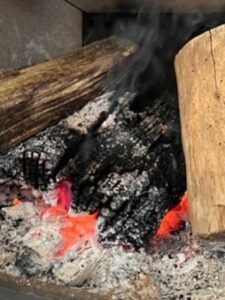C.F. Dunn's Blog, page 3
April 18, 2022
Home-baked.
Easter Sunday was full-on with me getting up at 4am for the sunrise service on the beach and then back home to cook. Today I’m taking it easy. Easy-ish – apart, that is, for prepping tea for my Beloved Parents. And as my pa has baked his famous shortbread and infamous chocaholic, all we’re doing is providing tea, coffee and savoury snacks. However, since beginning to write this, I can now hear Child Two in the kitchen. That bodes well for the taste buds (but is lethal for the waistline) as she is probably cooking her stonkingly good chocolate brownies, the likes of which have to be tasted to be believed. I wish I had more will-power to resist, but the simple truth is that I don’t – not when it comes to home-baked delights.
The post Home-baked. appeared first on C.F.Dunn.
April 4, 2022
Switching Off The Heating: A Few Home Truths
 It is freezing but we switched off the heating a month ago and have been relying on passive solar gain (i.e. sunshine through the windows) and log fires/burners to heat the house. I’ll let you into a secret: when we were growing up the copper warming pans and stone water bottles were not kept for decorative purposes.
It is freezing but we switched off the heating a month ago and have been relying on passive solar gain (i.e. sunshine through the windows) and log fires/burners to heat the house. I’ll let you into a secret: when we were growing up the copper warming pans and stone water bottles were not kept for decorative purposes.
As an aside to saving fuel costs, I’ve been monitoring the effects on the ambient temperature on us – and the house – and relating it to previous eras when central heating wasn’t a thing.
I grew up in cold regions – first in Lincolnshire, where the damp winds blow straight from the east and into your bones, then in Norway, where I don’t ever remember being cold despite the enduring snow and ice. 
The difference between the two was marked. In Lincolnshire, the walls were brick-built, the roof space uninsulated and the metal-framed windows (single-glazed) leaked like crazy. At night, insulation was provided by heavy curtains. We had a coke boiler in the kitchen and a small fireplace in the drawing room. We ran around in wooly socks and balaclavas, shorts or skirts, little mittens, and Startrite shoes in which our toes froze. That was it.
In Norway, our wooden house was heavily insulated, the windows secondary glazed, and the solid fuel stove provided ample hot water as well as keeping the house warm. We dressed for the cold and never felt it.
What of now? We live in an old house with C16th origins and state-of-the-art additions built in 1902. The walls are thick, we have insulated the loft copiously, and have secondary-glazed the windows (the metal frames had 1cm gaps when we moved in).
 The house gets very cold over a few days if left unheated. Until the 1990s it didn’t have central heating at all. However, every room has a working fireplace and the main rooms have big windows facing south. These windows gather the sun in winter but the angles ensure the rooms remain temperate in summer. On cold sunny days we don’t need additional heating until sunset. On cloudy days it is a different matter altogether and we light the fires and log burners in my study, the hall and the sitting room (I can’t write if my fingers and feet are cold). These keep the chill from those rooms, but the rest of the house remains unpleasantly cool.
The house gets very cold over a few days if left unheated. Until the 1990s it didn’t have central heating at all. However, every room has a working fireplace and the main rooms have big windows facing south. These windows gather the sun in winter but the angles ensure the rooms remain temperate in summer. On cold sunny days we don’t need additional heating until sunset. On cloudy days it is a different matter altogether and we light the fires and log burners in my study, the hall and the sitting room (I can’t write if my fingers and feet are cold). These keep the chill from those rooms, but the rest of the house remains unpleasantly cool. 
So, after a month in which the outside temperature varied from a balmy +18 degrees to -1, we came to the conclusion that:
To keep the fires stoked in all the rooms would require constant attention and barrow-loads of wood, notwithstanding the need for fuel to cook and heat water if we didn’t have a modern hob and oven.The sun is a vital source of heat – during daylight hours and when not obscured by cloud.Even with the fires lit and the sun shining, we have been unable to raise the temperature of the house to more than 16.5 degrees centigrade.Most of the house remains chilly, reminding me of my grandparents’ old home in Stamford, where we would scuttle as fast as we could to the lavatory and back to the relative warmth of the drawing room, admiring on the way the vapour rising through the stone-flagged floor.Being cold makes us prone to rattiness, less likely to leave the warm spots in the house, and generally curled in on ourselves as we huddle against the chill.We eat more.Shutting doors in the house makes a HUGE difference. And do you remember, ye of a certain age, the home-made draught excluders like long, stuffed sausages that sat at the bottom of the doors? We used them for a reason.Curtains, blinds, shutters are the BEST form of insulation at night.
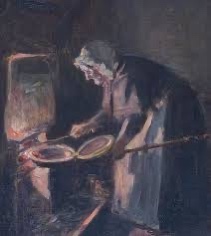 Taking all this into account and relating it to historic periods in a completely non-academic and untested way:
Taking all this into account and relating it to historic periods in a completely non-academic and untested way:
Shivering in this cold snap, we are thankful to have clothes to layer and to have south-facing windows to capture the sun when it shines – and wood, and the fireplaces in which to burn it, when it doesn’t. But I am acutely aware that most people don’t. Whether due to the current fuel crisis or because of an unjust war, too many people are without access to something we have become accustomed to over the last few generations: ready warmth. We can no longer rely on wood, oil, coal and gas to stave off winter cold, but must seek alternatives and soon. Complacency has just come face-to-face with reality.
The post Switching Off The Heating: A Few Home Truths appeared first on C.F.Dunn.
March 18, 2022
New Book Release: The Wounds of Time by S.L. Russell
Hooray! Hurrah! The 21st March, 2022 sees the eagerly awaited launch of author S.L.Russell’s latest contemporary novel The Wounds of Time and, for me, this is her best novel to date.
Set in the fictional town of Brant, and maintaining the link with characters in each of the two preceding Brant novels – The Healing Knife and The Thorn of Truth – The Wounds of Time can be read as part of the series or as a stand-alone book.
The protagonist in this case is Janet, a strong-minded, independent woman of middling years, who has clawed her way out of a challenging childhood to become the highly respected Senior Clerk of Chambers. Top of her game and queen of her small realm, at first glance Janet is a prickly character and not someone that ticks the usual protagonist boxes. She can be abrasive, standoffish, even a touch arrogant. She doesn’t suffer fools and is quite likely to tell them as much. But beneath the hard shell is a woman with whom many readers can identify and therein lies just one aspect of S.L. Russell’s skill as a writer. The author deftly conjures a complex, believable character who faces difficult circumstances but does not neatly overcome them. Instead, Janet does what we all do: reacts imperfectly to changing circumstances, makes wrong decisions (albeit with good intentions), and alienates those closest to her as she builds a shield wall to protect herself and others. Simply put, Janet is a recognisable, multi-coloured individual, not bleached of her imperfections for the sake of narrative, but someone we grow to know and care about as we make the journey with her.
And while S.L. Russell’s books have a benign disposition (there is nothing offensive in terms of language or content) they are neither cosy nor sentimental. Each deals with life situations with a clear-sighted reality as down to earth and compassionate as the author herself. Sue Russell is the champion of real and The Wounds of Time is likely to provoke a degree of gentle self-reflection.
Tightly plotted and with a building tension, The Wounds of Time is written in a concise style with an exquisite use of language, leaving a lingering impression – a resonance akin to eating a fine, dark chocolate – delighting the senses and satisfying in its depth.
The Wounds of Time is available to order: https://amzn.to/3JqoJIk
Books in the Brant series:
The post New Book Release: The Wounds of Time by S.L. Russell appeared first on C.F.Dunn.
January 19, 2022
Soggy Bottoms: Protecting Plants in Winter
 The sun has made a welcome appearence and beckons to me. Plants are similarly beguiled and the first signs of spring are there in the green shoots beneath overhanging hedges. It’s that time of year when an unexpected frost can nip tender plants. As a result, I’ve been out and about protecting the most susceptible. Those that don’t need the shelter of the greenhouse – such as pelargoniums and over-wintered physalis – might still fall foul if we have a really sharp spell of cold weather.
The sun has made a welcome appearence and beckons to me. Plants are similarly beguiled and the first signs of spring are there in the green shoots beneath overhanging hedges. It’s that time of year when an unexpected frost can nip tender plants. As a result, I’ve been out and about protecting the most susceptible. Those that don’t need the shelter of the greenhouse – such as pelargoniums and over-wintered physalis – might still fall foul if we have a really sharp spell of cold weather.
The semi-hardy plants fall into three main categories: those that hate having soggy bottoms (and who doesn’t?) and crowns, those that loath dry winds and frost, and those that despise both. Open-structured stems especially fall prey to sub-zero temperatures, the moisture freezing and expanding until the stems are reduced to a brown, rotting mass.
 In areas of the UK where a prologned frost can be expected most winters, it is traditional to lift softies like dahlias, but here is the balmy South West we can push our luck and leave the tubers in the ground. I’ve tried both ways, but prefer to leave the tubers undisturbed if I can. The east border is pretty much sheltered from the worst weather and what the walls can’t provide in terms of shelter, Salvia Hot Lips does the rest. On the south side of the house, though, the short border gets blasted by wind and rain straight off the sea. Here the dahlias need more than Salvia Amistad offers and I provide them with a thick coat of Strulch or other mulching material to protect them from the twin monsters of wet and cold. This seems to do the trick. I say that in the hope that we are not faced with another Beast From The East (although snow is a surprisingly good insulator).
In areas of the UK where a prologned frost can be expected most winters, it is traditional to lift softies like dahlias, but here is the balmy South West we can push our luck and leave the tubers in the ground. I’ve tried both ways, but prefer to leave the tubers undisturbed if I can. The east border is pretty much sheltered from the worst weather and what the walls can’t provide in terms of shelter, Salvia Hot Lips does the rest. On the south side of the house, though, the short border gets blasted by wind and rain straight off the sea. Here the dahlias need more than Salvia Amistad offers and I provide them with a thick coat of Strulch or other mulching material to protect them from the twin monsters of wet and cold. This seems to do the trick. I say that in the hope that we are not faced with another Beast From The East (although snow is a surprisingly good insulator).
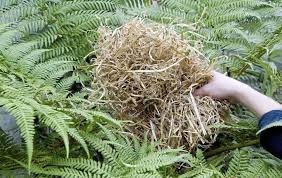 I can’t mulch our tree ferns (Dicksonia antartica), but Eric and Ericson (see what I did there?) are on a raised terrace area and exposed to drying winds. They have been with us for decades and I used to cosset them with swathes of old towels covered with black bin liners until temperatures rose to a more acceptable 15 C. However, this made them more prone to rot in their lovely knobbly crowns, so an alternative method had to be employed. This proved to be an age-old method of using sacking stuffed with straw, allowing the wooly crowns to breath while providing an insulating layer.
I can’t mulch our tree ferns (Dicksonia antartica), but Eric and Ericson (see what I did there?) are on a raised terrace area and exposed to drying winds. They have been with us for decades and I used to cosset them with swathes of old towels covered with black bin liners until temperatures rose to a more acceptable 15 C. However, this made them more prone to rot in their lovely knobbly crowns, so an alternative method had to be employed. This proved to be an age-old method of using sacking stuffed with straw, allowing the wooly crowns to breath while providing an insulating layer.
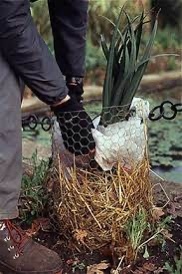 It’s a method used extensively throughout the medieval period and is still used today. Now a cage of chicken wire restrains the straw over which sacking covers all. In the more distant past, open woven structures of willow or hazel might form a cone slipped over a frost-tender plant and this filled with straw. Vases or planters, too large to be moved from the open garden, could be wrapped in sacking to prevent frost shattering the fragile clay and to protect the contents. Smaller pots were often placed against a wall to gain the double benefit of shelter from icy winds and the release of stored warmth from the sun. If snow threatened, staves – bound together to make a crude trellis – could be propped at an angle like a lean-to and covered with sacking or sheaves of rushes as a make-shift roof.
It’s a method used extensively throughout the medieval period and is still used today. Now a cage of chicken wire restrains the straw over which sacking covers all. In the more distant past, open woven structures of willow or hazel might form a cone slipped over a frost-tender plant and this filled with straw. Vases or planters, too large to be moved from the open garden, could be wrapped in sacking to prevent frost shattering the fragile clay and to protect the contents. Smaller pots were often placed against a wall to gain the double benefit of shelter from icy winds and the release of stored warmth from the sun. If snow threatened, staves – bound together to make a crude trellis – could be propped at an angle like a lean-to and covered with sacking or sheaves of rushes as a make-shift roof.
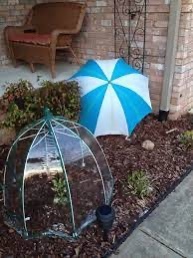 Even now – when plastic umbrellas sprout over arid-loving plants in Abbotsbury Subtropical Gardens like glossy mushrooms – the tried and tested methods prevail. Increasingly, I forego the use of plastics in favour of straw, the latter lending greater insulation than chilly plastic and the dubious benefits of horticultural fleece. As long as enough air can circulate around the crowns or necks, there is little risk of rot. And, if laid as a mulch, straw will protect the roots and keep the soil relatively warm. Come spring, worms will have integrated some of the material into the soil and the rest can be added to the compost heap. Both will add valuable nutrients to be taken up by new growth. Yet it is only by mid summer that I will discover whether my risky strategy has paid off when the dahlias begin to bloom.
Even now – when plastic umbrellas sprout over arid-loving plants in Abbotsbury Subtropical Gardens like glossy mushrooms – the tried and tested methods prevail. Increasingly, I forego the use of plastics in favour of straw, the latter lending greater insulation than chilly plastic and the dubious benefits of horticultural fleece. As long as enough air can circulate around the crowns or necks, there is little risk of rot. And, if laid as a mulch, straw will protect the roots and keep the soil relatively warm. Come spring, worms will have integrated some of the material into the soil and the rest can be added to the compost heap. Both will add valuable nutrients to be taken up by new growth. Yet it is only by mid summer that I will discover whether my risky strategy has paid off when the dahlias begin to bloom.
The post Soggy Bottoms: Protecting Plants in Winter appeared first on C.F.Dunn.
January 16, 2022
Ruling the Waves: Henry V’s Great Ships
The post Ruling the Waves: Henry V’s Great Ships appeared first on C.F.Dunn.
January 1, 2022
2022: The First Day of the Rest of the Year.
How have you spent the first day of the new year? Having prepared the stollen that I somehow missed at Christmas, I have spent the rest of the first day of 2022 ensconced in my study. The files – ordered months ago – have finally arrived. Now labelled, they have taken a wealth of research material, notebooks, specialist articles – all the bits and pieces garnered for the current writing project.
Sorting and filing are apt metaphores for the process of preparing for the new writing year. Even if Book 3 of the series is well underway, there’s a sense of renewed vigour, a fresh beginning.
I love the weeks of festive preparation in the lead up to Christmas with its delightfully chaotic, diamond-bright cheerfulness as absorbing now as it was to me as a child. Yet there’s something about the turn of the year that calls for a reflective mien. Perhaps it is the lull after the Christmas rush, or the quiet, dark days in the depths of winter. Or is it the hibernation of the self before spring awakens the senses and drives us from our insularity?
Now listening to my writing playlists while making notes, I’m shaking off December’s dust and readying myself for the year ahead. On my list of things I wish to achieve (aside from all those relating to the garden, house and family) is a pile of books I want to read (research-related and novels), a research trip for the current project and preparation for the next. I have a conference to go to as well as several literary festivals. Covid notwithstanding, I’d like to meet up with author friends because there is only so much a Zoom get-together can deliver. But much of that is dependent upon the unpredictable outcomes of the present pandemic as well as life’s twists and turns such as had me bed-ridden for fifteen weeks last year with a broken leg. Is it no wonder then, that we look to those things we can control – books and shelves, our little spaces – that make up the safe part of our lives? There is comfort there among the regularity of numbered pages, the neatly labelled files, the array of pens and coloured tags and the pristine notebooks waiting for the first impression of a fresh idea.
So forgive me if I linger here a while longer, temporarily secreted from the volcanic anxiety of a stressed world as I navigate the paths of a known past. Standing at the gate of the year, I’m taking a moment to rest and relfect before taking the first step into 2022 with all the vicissitudes and possibilities it offers. Whatever road you find yourself on, may you find it a bright and smooth way. Happy New Year!
The post 2022: The First Day of the Rest of the Year. appeared first on C.F.Dunn.
December 24, 2021
Happy Christmas.
The hour grows late. The turkey’s stuffed, the mulled wine sozzled, and it is time to wish you all a very kind and content Christmas and a happy New Year. God rest ye merry, everyone!
The post Happy Christmas. appeared first on C.F.Dunn.
December 15, 2021
Victorian Family Recipes From Christmas Past
Do you think that most families have favourite recipes that make an appearance, like Marley’s ghost, at Christmas? Recipes that have been tweaked down the years, but are basically the same as when first concocted way back beyond memory?
During our mammoth unpacking we came across family recipe books dating from the Victorian period and later. These books would be brought out on occassion to be raided for old favourite dishes, the preperation of which would be accompanied by stories of the women who wrote them. Some of the recipes – all hand written – had been passed from one generation to the next. Many originated as a result of trial and error in the kitchens of Georgian wives; a few predate even those.
Here, my husband’s great-grandmother, Ethel Chapman, aged 20, records a few favourite recipes in a little book dated 31st January, 1876.
Gingerbread – aunt B’s
Melt 1/2lb butter in 1 lb of treacle
then add one pound flour, 1oz ground
ginger, (1/2oz carroway (sic), 1/2 oz corriander seeds, a little nutmeg) (crossed out)
3 eggs & a teaspoonful of carbonate
of soda. Bake for 2 hours in a
well papered tin in an oven
almost cold at first, heating gradually.
The post Victorian Family Recipes From Christmas Past appeared first on C.F.Dunn.
December 14, 2021
In For Christmas
At last – after four years of working on the house surrounded by 500+ packing boxes and dust – we have finally unpacked and are in. OK, so the hall is still a tool shed and if you try to manoeuvre through it you stand a good chance of knocking over the stacks (and I mean stacks to rival B&Q) of paint tins. Yes, it’s true that we could probably supply enough wire wool, sandpaper, filler and varnish to renovate several houses, and perhaps there are a good few months of snagging work to do in dark corners, but that’s nothing compared with what has been achieved. So, all in all (and with two dogs acquired and two books written) four years down the line we consider ourselves MOVED. 
The post In For Christmas appeared first on C.F.Dunn.
August 18, 2021
Gardening Update: Some You Win, Some You Lose
 As harvesting continues and the growing season in the vegetable and fruit garden winds down, it’s time for reflection and a gardening update on the year.The foliage from the potatoes has been completely cleared now and the tatties are resting in the ground for a couple of weeks until the threat of contamination from the blight has passed. Only then will we know if the potatoes themselves have escaped unscathed.
As harvesting continues and the growing season in the vegetable and fruit garden winds down, it’s time for reflection and a gardening update on the year.The foliage from the potatoes has been completely cleared now and the tatties are resting in the ground for a couple of weeks until the threat of contamination from the blight has passed. Only then will we know if the potatoes themselves have escaped unscathed.
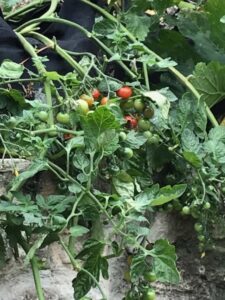 Meanwhile, the first blight showed on the tomatoes yesterday and this morning I finished removing all the foliage from the plants. This won’t halt the progress of the blight, but might slow it enough to give the fruit a chance to ripen. As it is, this year’s crop has been poor – a combo of indifferent weather and my lack of attention due to The Broken Leg. Still, what there are might make a few jars of green chutney.
Meanwhile, the first blight showed on the tomatoes yesterday and this morning I finished removing all the foliage from the plants. This won’t halt the progress of the blight, but might slow it enough to give the fruit a chance to ripen. As it is, this year’s crop has been poor – a combo of indifferent weather and my lack of attention due to The Broken Leg. Still, what there are might make a few jars of green chutney.
 The squash have done remarkably well given the conditions, and the courgettes have fruited better this year than last.Blight has been a theme for the last three years. I can’t do anything about it with the potatoes outdoors, but I am going to try some tomatoes in the greenhouse next year along with garlic, which consistently fails or is rusted outside. I’ve also noticed that the stray tomato plant growing tucked away in another part of the garden has yet to feel the fingers of blight, so that is worth keeping in mind for next year.In other garden news, the magnificent crop of plums has been discovered by squirrels. Millie and Thegn guard the tree when they can, but it’s a thankless task. Last year wasn’t such a problem, but perhaps that is because the pesky creatures were busy stripping the walnut tree instead. We have a device usually used to deter herons from the pond – a motion-sensor spray attached to a hose – which we are considering giving a go in the orchard. It will need a very long hose, but if it works, is something we can deploy for other fruit trees.
The squash have done remarkably well given the conditions, and the courgettes have fruited better this year than last.Blight has been a theme for the last three years. I can’t do anything about it with the potatoes outdoors, but I am going to try some tomatoes in the greenhouse next year along with garlic, which consistently fails or is rusted outside. I’ve also noticed that the stray tomato plant growing tucked away in another part of the garden has yet to feel the fingers of blight, so that is worth keeping in mind for next year.In other garden news, the magnificent crop of plums has been discovered by squirrels. Millie and Thegn guard the tree when they can, but it’s a thankless task. Last year wasn’t such a problem, but perhaps that is because the pesky creatures were busy stripping the walnut tree instead. We have a device usually used to deter herons from the pond – a motion-sensor spray attached to a hose – which we are considering giving a go in the orchard. It will need a very long hose, but if it works, is something we can deploy for other fruit trees.
 The onions have been curing and are almost ready for stringing. We still have three from last year so are delighted that we can grow enough to keep us in onions from harvest to harvest. Like many gardeners, some you win, some you don’t. That’s the nature of the ever changing game.
The onions have been curing and are almost ready for stringing. We still have three from last year so are delighted that we can grow enough to keep us in onions from harvest to harvest. Like many gardeners, some you win, some you don’t. That’s the nature of the ever changing game.The post Gardening Update: Some You Win, Some You Lose appeared first on C.F.Dunn.

